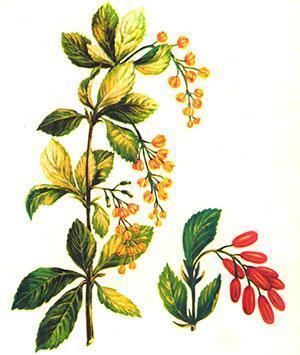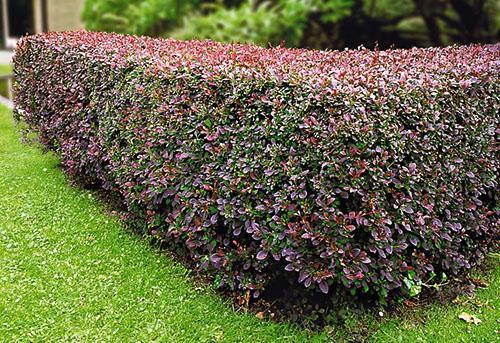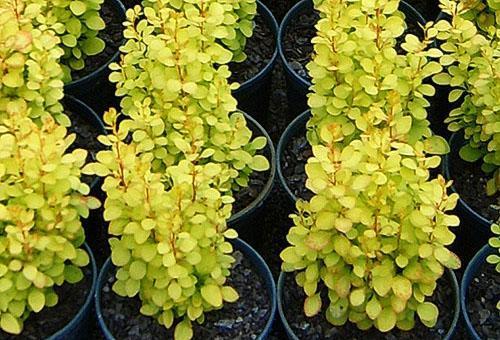Planting and caring for a spectacular barberry shrub
 The unpretentious shrub is well known to gardeners all over the world. Today, about five hundred species of barberry are known, which can be interesting due to their medicinal and decorative properties. Many plants are used as fruit bushes. And during flowering, a lot of bees flock to the plants, which makes the culture a valuable honey plant.
The unpretentious shrub is well known to gardeners all over the world. Today, about five hundred species of barberry are known, which can be interesting due to their medicinal and decorative properties. Many plants are used as fruit bushes. And during flowering, a lot of bees flock to the plants, which makes the culture a valuable honey plant.
For those who want to see barberry on their site, planting and caring for the shrub will not cause serious difficulties. And yet, you should know about some of the peculiarities of culture in advance.
Preparing the landing site
In nature, large spreading barberry bushes can be found on clearings that are beginning to grow and on dry sunny slopes. Therefore, in the garden, you will have to find a fairly spacious area with good lighting of the place, not shaded, but protected from drafts.
- The shrub has an extremely negative attitude to the proximity of groundwater and stagnant moisture, so it is better to plant it on a slope or a small hill.
- The soil for planting barberry should be light and loose. The culture does not suffer from a lack of organic matter in the soil, but with its excessive acidity above pH 7.5, it is better to take care of introducing limestone or dolomite flour under the bush.
- If loams or chernozems prevail on the site, good drainage must be provided for the barberry and peat or limestone flour must be added.
- On peatlands, liming is carried out, and also wood ash.

- For shrubs no older than three years old, the pit should have a diameter of about 25 cm and a depth of 25-30 cm.
- For seedlings from 4 to 7 years old, a hole is prepared with a diameter of about 50 cm and the same depth.
- If the barberry is planted to create a hedge, a 40 cm deep and wide trench will be required.
When the planting site is ready, a nutritious substrate is needed to fill it from a mixture of equal parts of humus or compost, sand and loose garden soil. Superphosphate is often used as a fertilizer when planting barberry.
How to plant barberry?
If the root system of the seedling in the container is reliably protected by a soil clod, you can transplant the plant at any convenient time, after thoroughly wetting the container with the young bush.
 But when to plant barberry, if the gardener has a rooted cutting or cuttings with open roots at his disposal?
But when to plant barberry, if the gardener has a rooted cutting or cuttings with open roots at his disposal?
- The best time for an event is spring. It is important to have time to plant the plant at the moment. When the soil has already warmed up, but has not dried up, and the buds have not yet begun to grow.
- If time is lost, it is possible to plant barberry in the fall, when the shrub begins to lose its foliage, and all life processes in the plant begin to slow down.
Barberry can be propagated both by vegetative puts and by seeds from ripe berries. When a barberry is already growing on the site, bushes from 3 to 5 years old with branching below the ground level can be divided, getting two or three seedlings with an independent root system, and planted.
Almost all species are easy to propagate through green cuttings:
- It is necessary to select branches for grafting from strong shoots of this year, sufficiently elastic and brittle when bent.
- Unripe cuttings run the risk of rotting and acclimatizing longer when planting.
- And the rough, lignified parts of the branches are more difficult to root. If they are used for planting barberry, cuttings are cut in the fall and stored until spring at temperatures close to zero.
 The middle parts of the shoots suitable for grafting with a diameter of about 0.5 cm are divided into segments from 7 to 10 cm long with two healthy nodes and one internode between them. If the stalk is too short, you can leave three pairs of leaves.
The middle parts of the shoots suitable for grafting with a diameter of about 0.5 cm are divided into segments from 7 to 10 cm long with two healthy nodes and one internode between them. If the stalk is too short, you can leave three pairs of leaves.
- The top on a piece of the shoot is cut horizontally.
- The bottom cut should have a 45 ° angle.
- At the top node, the leaves are cut in half.
- The lower leaves are removed completely without affecting the axillary buds and thorns.
It is better to root barberry in a sand-peat mixture, in which the cuttings are immersed at an angle of 45 °. 5 cm is left between the rows, and from one cutting to another should be at least 10 cm.
For better survival, you can use Kornevin, indoleacetic acid or other stimulants, as well as create temperature favorable for barberry, from 20 to 25 ° C, and humidity conditions. To maintain air humidity of about 85%, plantings are watered up to twice a day.
When the barberry gives roots, small seedlings continue to grow in greenhouse conditions for up to two years, and then the barberry is planted in the fall or spring in the ground.
Propagation of barberry by seeds
You can get seeds for sowing by thoroughly kneading fresh berries. The recovered grains are washed and dried thoroughly.
- If sowing is carried out in the fall, then for seeds in a loose nutrient soil, it is enough to make grooves of a centimeter depth up to 1 cm deep.
- When planting in spring, the seeds are stratified. The procedure takes place at a temperature of 2 to 5 ° C and lasts from two to four months, depending on the variety and type of barberry.
 As the seedlings develop two true leaves, they can be thinned out, leaving one plant for every three centimeters. The further process goes in the same way as in the case of propagation by cuttings. And after two years the time comes when you can plant barberry in a permanent place in the garden.
As the seedlings develop two true leaves, they can be thinned out, leaving one plant for every three centimeters. The further process goes in the same way as in the case of propagation by cuttings. And after two years the time comes when you can plant barberry in a permanent place in the garden.
How to care for barberry?
Adult barberry bush is not so demanding in watering, the main thing is that moisture is in abundance at the stage of planting and rooting.
The shrub planted in the garden can be watered only when the soil under the crown has significantly dried out. It is much more important that the soil is thoroughly loosened so that oxygen and moisture have free access to the roots of the barberry.
 To preserve moisture and improve the structure of the soil under the crown, it is mulched with an 8-centimeter layer of peat, sawdust or other available means. How to care for barberry during the warm season? Does the plant require feeding, and what fertilizers are preferred for this crop?
To preserve moisture and improve the structure of the soil under the crown, it is mulched with an 8-centimeter layer of peat, sawdust or other available means. How to care for barberry during the warm season? Does the plant require feeding, and what fertilizers are preferred for this crop?
- From the second year of life, the shrub should receive nitrogen-containing spring feeding. Barberry responds well to watering with diluted infusion mullein or bird droppings.
- Before flowering adults barberry shrubs receive complex fertilizers with microelements. It is better if these are granular products that will gradually enrich the soil under the crown.
- In September, 10 grams of potash fertilizers and 15 grams of superphosphate are applied under the bushes for each plant.
Annual fertilization is not required; it is enough for the barberry to receive such support once every two or three years.
How to prune barberry?
 No matter how simple planting and caring for barberry was, the photo clearly shows well-developed thorns, which literally planted all the branches of the bush. They then constitute the most serious problem for the gardener, because you cannot do without pruning the bush. In such work, durable gloves and tools with sufficiently long handles are vital.
No matter how simple planting and caring for barberry was, the photo clearly shows well-developed thorns, which literally planted all the branches of the bush. They then constitute the most serious problem for the gardener, because you cannot do without pruning the bush. In such work, durable gloves and tools with sufficiently long handles are vital.
 Low-growing varieties, often used in single plantings or as a decorative green border, can not be specially formed, but only damaged and dry shoots can be removed.But when and how to cut the barberry, if the shrub forms a dense hedge?
Low-growing varieties, often used in single plantings or as a decorative green border, can not be specially formed, but only damaged and dry shoots can be removed.But when and how to cut the barberry, if the shrub forms a dense hedge?
- In this case, the first molding pruning of plants is carried out a year after planting, and in more mature shrubs of bushes, branches from one to two years old are shortened by a third or even half the length.
- Barberry cutting is carried out after flowering and before the autumn cold.
During the spring cutting of the barberry, it is necessary to cut off or completely remove all damaged branches that have frozen over the winter and with signs of the presence of pests or diseases. The procedure must be carried out before foliage appears on the bushes.
Can you please tell me if she will be able to overwinter a barberry seedling in room conditions, if she did not manage to plant it. The sapling has left the leaves again
Good day!
It is theoretically possible to save a barberry seedling in room conditions until the moment when it can be planted in the ground in spring.
To do this, you need to pick up a fairly spacious pot and plant the plant, providing drainage and a nutritious soil mixture in which the bush will be comfortable. True, this does not end with caring for the plant. Since barberries are photophilous, the seedling needs illumination, otherwise by spring there is a risk of getting a weakened plant with elongated shoots. In addition, there is a possibility that the air in the apartment will be too dry for the bush. And here the need for spraying arises.
Barberry grows at home, but as a potted bonsai plant. If the bush is to be planted in the garden, it is better not to torment it.
It is reasonable to carefully remove the foliage that has appeared, and the plant should be transferred to a ventilated dry basement with a temperature of 0 to +5 ° C. In such conditions, the barberry will wait for the warmth and quickly take root. The main thing is that the temperature is not higher, and the plant does not grow. Or there was no frost in the room, and the roots did not suffer. You can protect the seedling from external influences and drying by wrapping it in a layer of wrapping paper, and on top of it in non-woven material, leaving a gap above the root collar for ventilation. Don't forget the protection against rodents!
You can try to keep the barberry on the balcony by insulating the root system. For example, by packing the seedling in a box with dry sawdust or foam. For the crown, burlap or a combination of paper and spunbond is used.